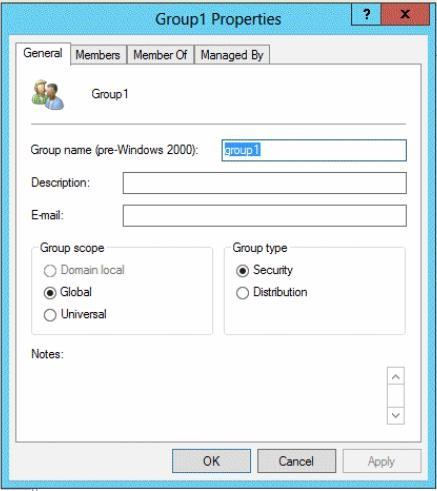File Info
| Exam | Installing and Configuring Windows Server 2012 |
| Number | 70-410 |
| File Name | Microsoft.70-410.Train4Sure.2018-09-20.315q.tqb |
| Size | 19 MB |
| Posted | Sep 20, 2018 |
| Download | Microsoft.70-410.Train4Sure.2018-09-20.315q.tqb |
How to open VCEX & EXAM Files?
Files with VCEX & EXAM extensions can be opened by ProfExam Simulator.
Coupon: MASTEREXAM
With discount: 20%





Demo Questions
Question 1
Your network contains an Active Directory domain named contoso.com. All servers run Windows Server 2012 R2.
You need to add a user named User1 to a group named ServerAdmins.
What command should you run? To answer, select the appropriate options in the answer area.
Correct answer: To work with this question, an Exam Simulator is required.
Question 2

Your network contains an Active Directory domain named contoso.com.
You log on to a domain controller by using an account named Admin1. Admin1 is a member of the Domain Admins group.
You view the properties of a group named Group1 as shown in the exhibit. (Click the Exhibit button.)

Group1 is located in an organizational unit (OU) named OU1.
You need to ensure that users from Group1 can modify the Security settings of OU1 only.
What should you do from Active Directory Users and Computers?
- Modify the Managed By settings on OU1.
- Right-click contoso.com and select Delegate Control.
- Right-click OU1 and select Delegate Control.
- Modify the Security settings of Group1.
Correct answer: C
Explanation:
Delegating control to only the OU will allow the users of Group1 to modify the security settings. Delegating control to only the OU will allow the users of Group1 to modify the security settings.
Question 3
Your network contains an Active Directory forest named contoso.com. The forest contains a single domain. All servers run Windows Server 2012 R2. The domain contains two domain controllers named DC1 and DC2. Both domain controllers are virtual machines on a Hyper-V host.
You plan to create a cloned domain controller named DC3 from an image of DC1.
You need to ensure that you can clone DC1.
Which two actions should you perform? (Each correct answer presents part of the solution. Choose two.)
- Add the computer account of DC1 to the Cloneable Domain Controllers group.
- Create a DCCloneConfig.xml file on DC1.
- Add the computer account of DC3 to the Cloneable Domain Controllers group.
- Run the Enable-AdOptionalFeaturecmdlet.
- Modify the contents of the DefaultDCCIoneAllowList.xml file on DC1.
Correct answer: AB
Explanation:
A. Membership in the Cloneable Domain Controllers Group dictates whether a DC can or cannot be cloned. This group has some permissions set on the domain head that should not be removed. Removing these permissions will cause cloning to fail. Also, as a best practice, DCs shouldn’t be added to the group until you plan to clone and DCs should be removed from the group once cloning is complete. Cloned DCs will also end up in the Cloneable Domain Controllers group. B. DCCloneConfig.xml is an XML configuration file that contains all of the settings the cloned DC will take when it boots. This includes network settings, DNS, WINS, AD site name, new DC name and more. This file can be generated in a few different ways. The New-ADDCCloneConfig cmdlet in PowerShell By hand with an XML editor By editing an existing config file, again with an XML editor. A. Membership in the Cloneable Domain Controllers Group dictates whether a DC can or cannot be cloned. This group has some permissions set on the domain head that should not be removed. Removing these permissions will cause cloning to fail. Also, as a best practice, DCs shouldn’t be added to the group until you plan to clone and DCs should be removed from the group once cloning is complete. Cloned DCs will also end up in the Cloneable Domain Controllers group.
B. DCCloneConfig.xml is an XML configuration file that contains all of the settings the cloned DC will take when it boots. This includes network settings, DNS, WINS, AD site name, new DC name and more. This file can be generated in a few different ways.
The New-ADDCCloneConfig cmdlet in PowerShell
By hand with an XML editor
By editing an existing config file, again with an XML editor.

